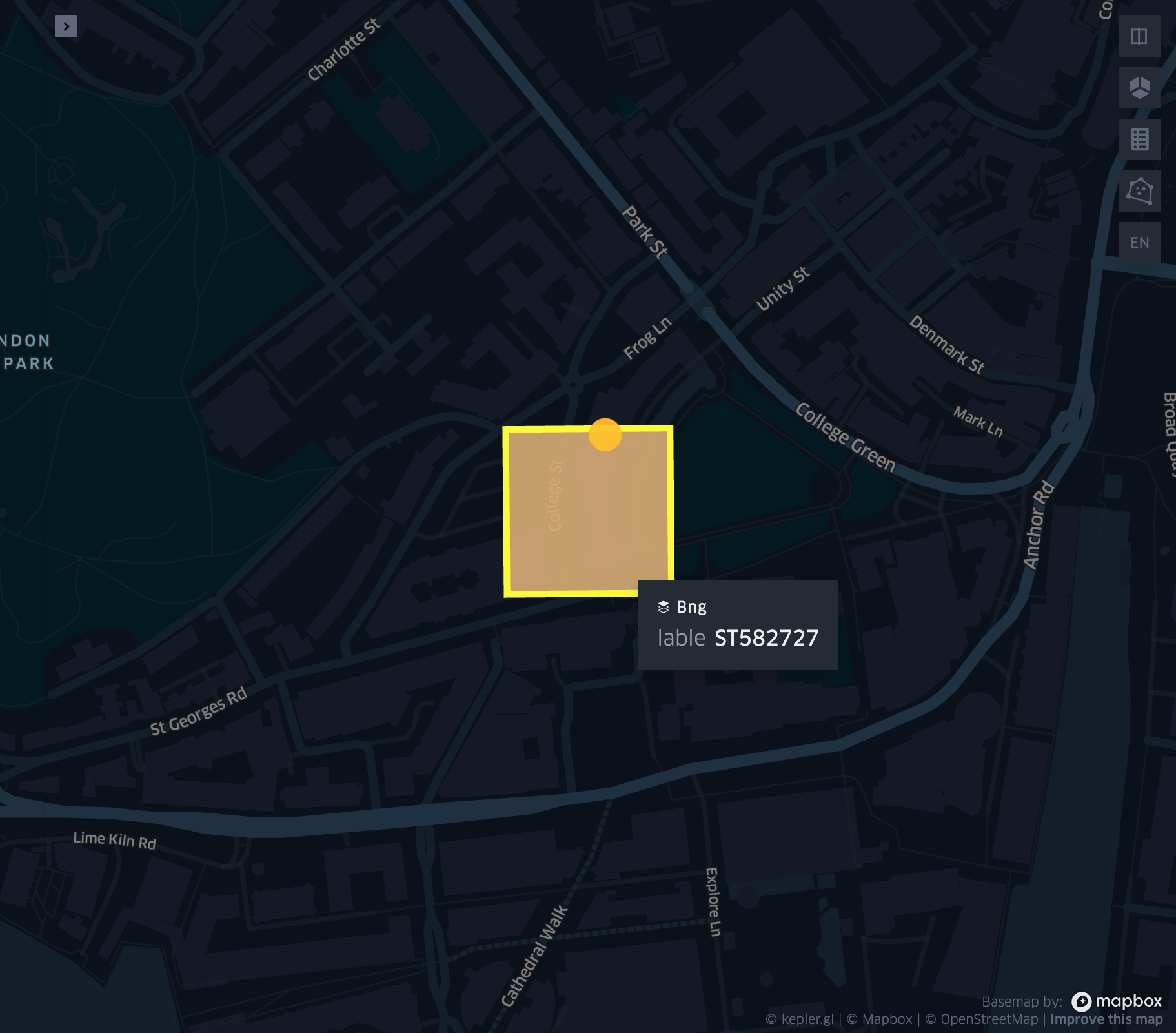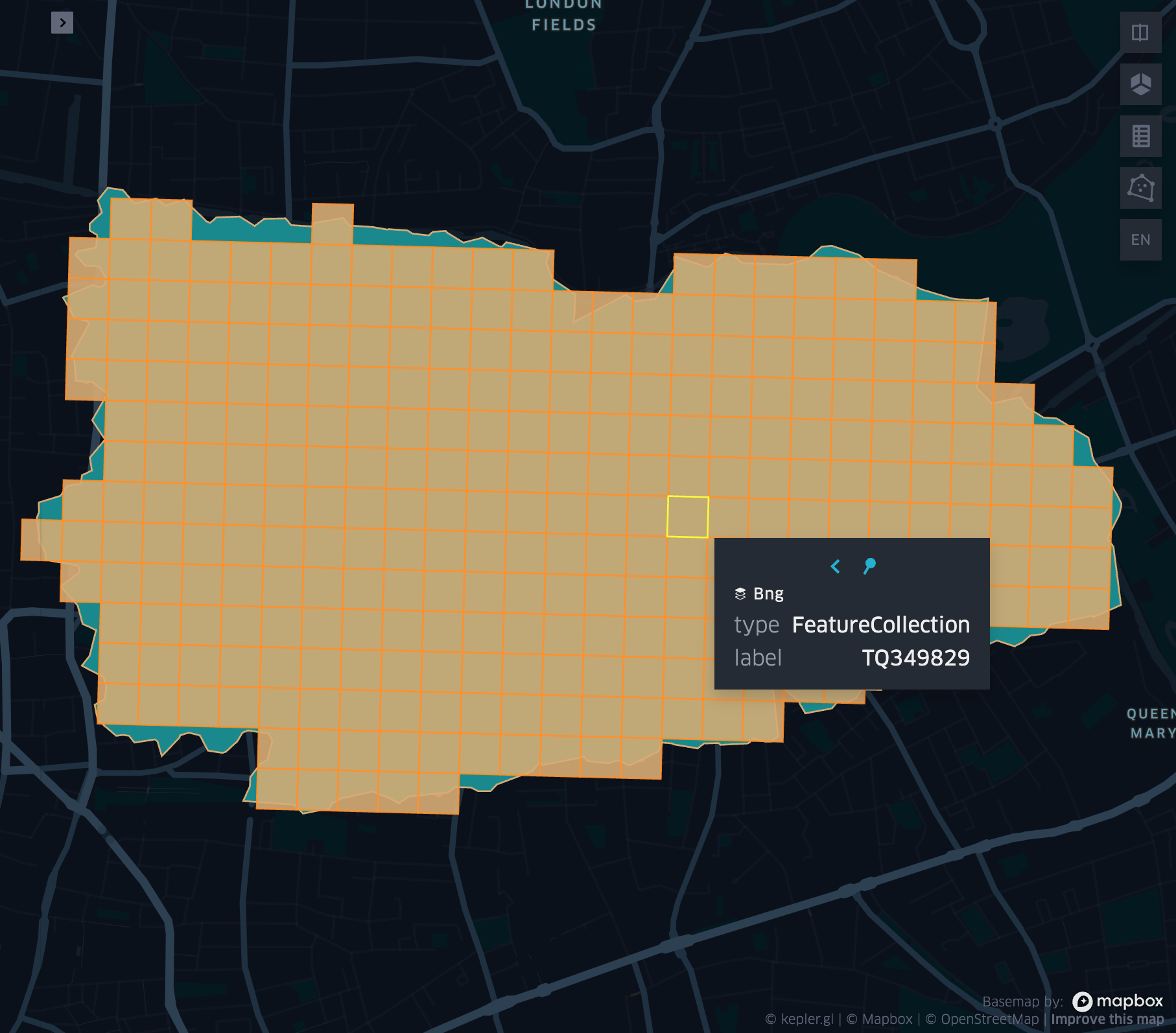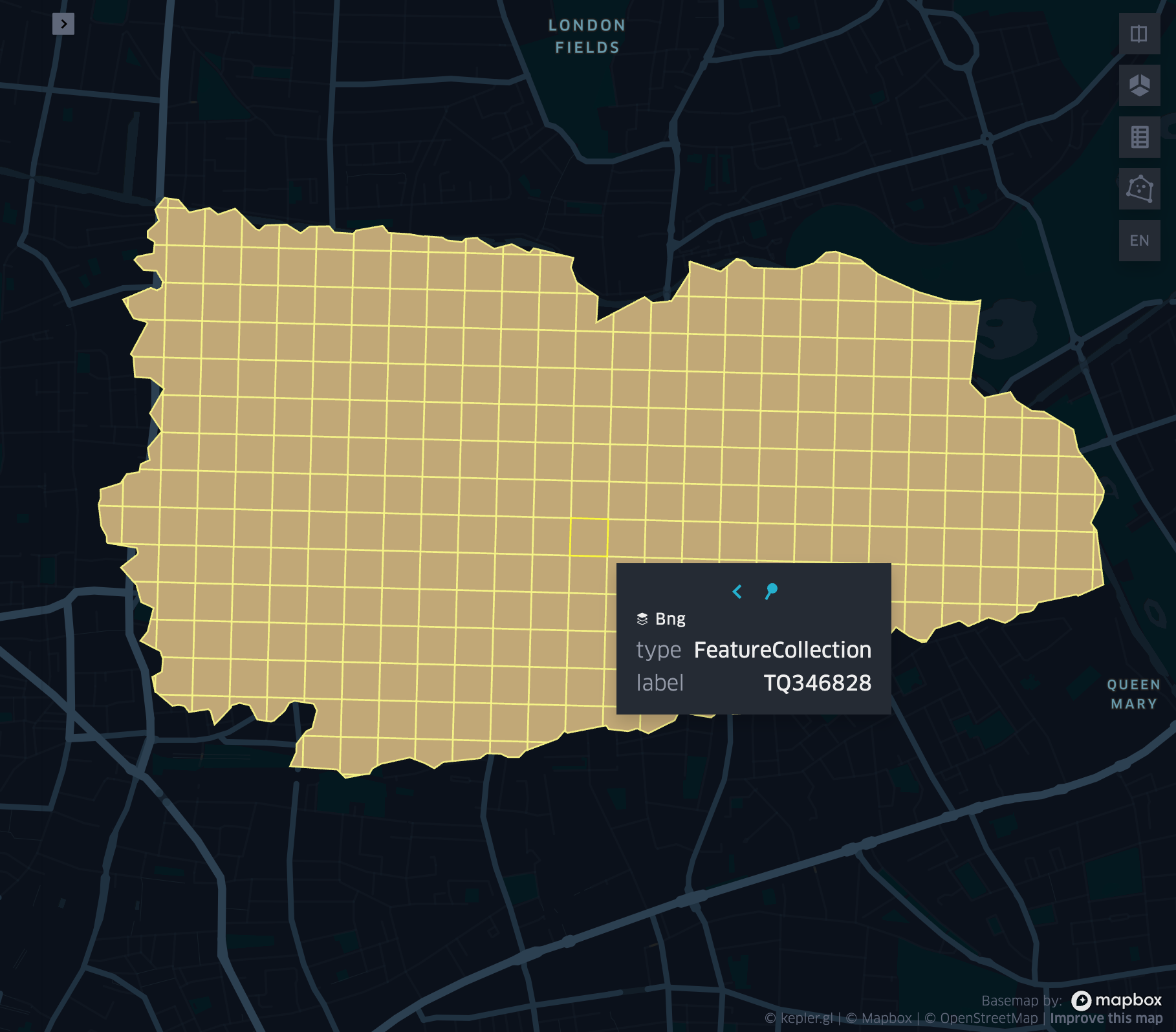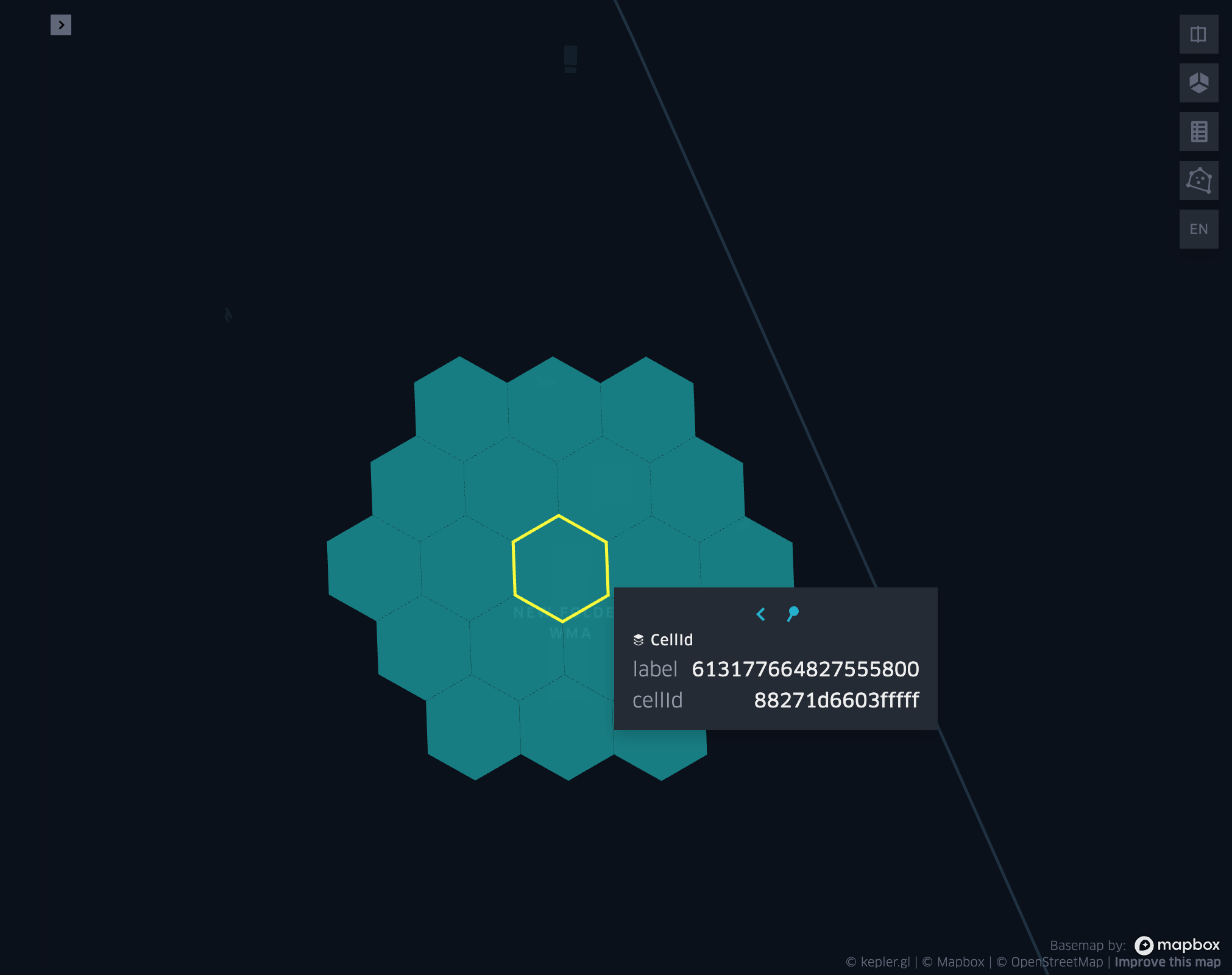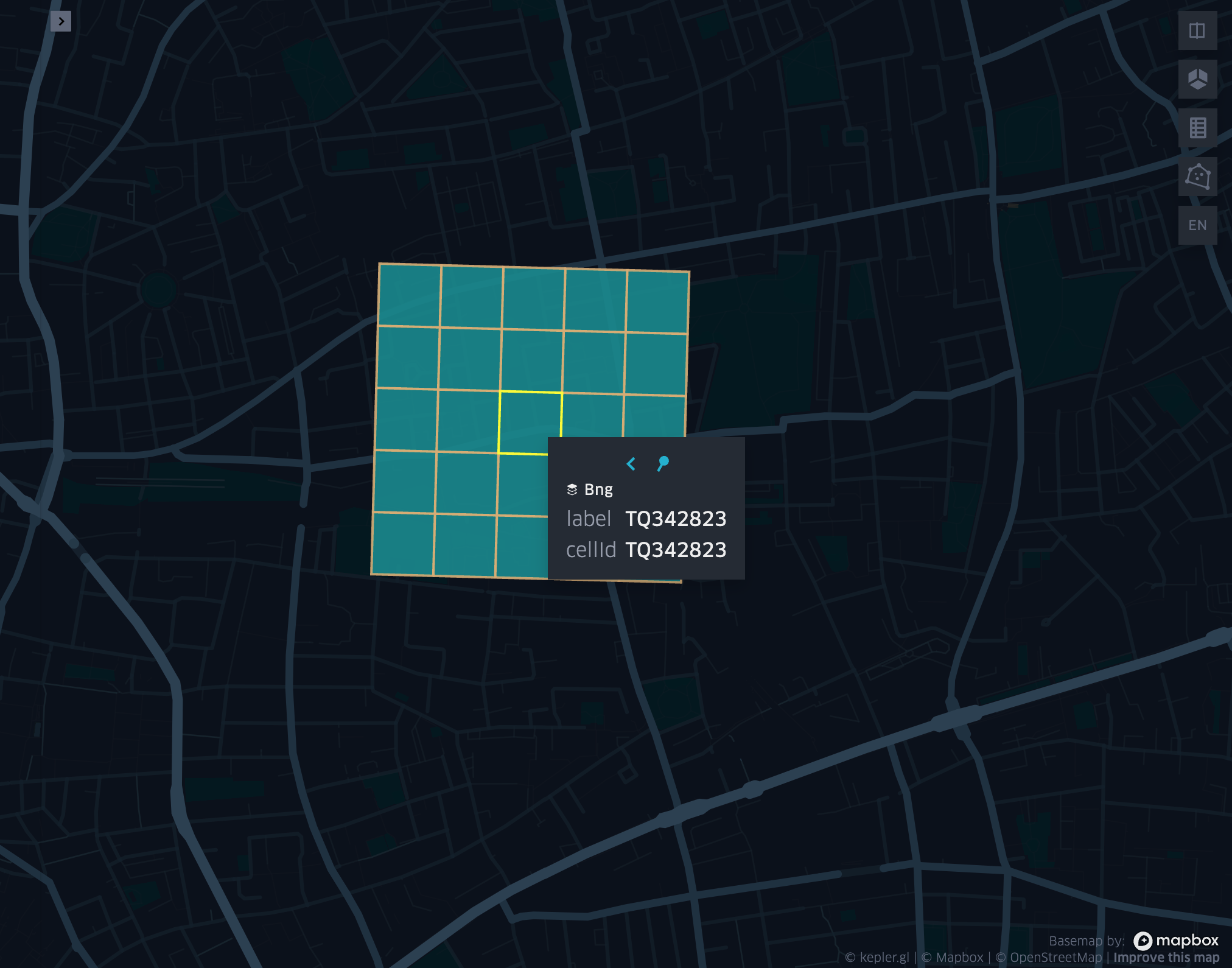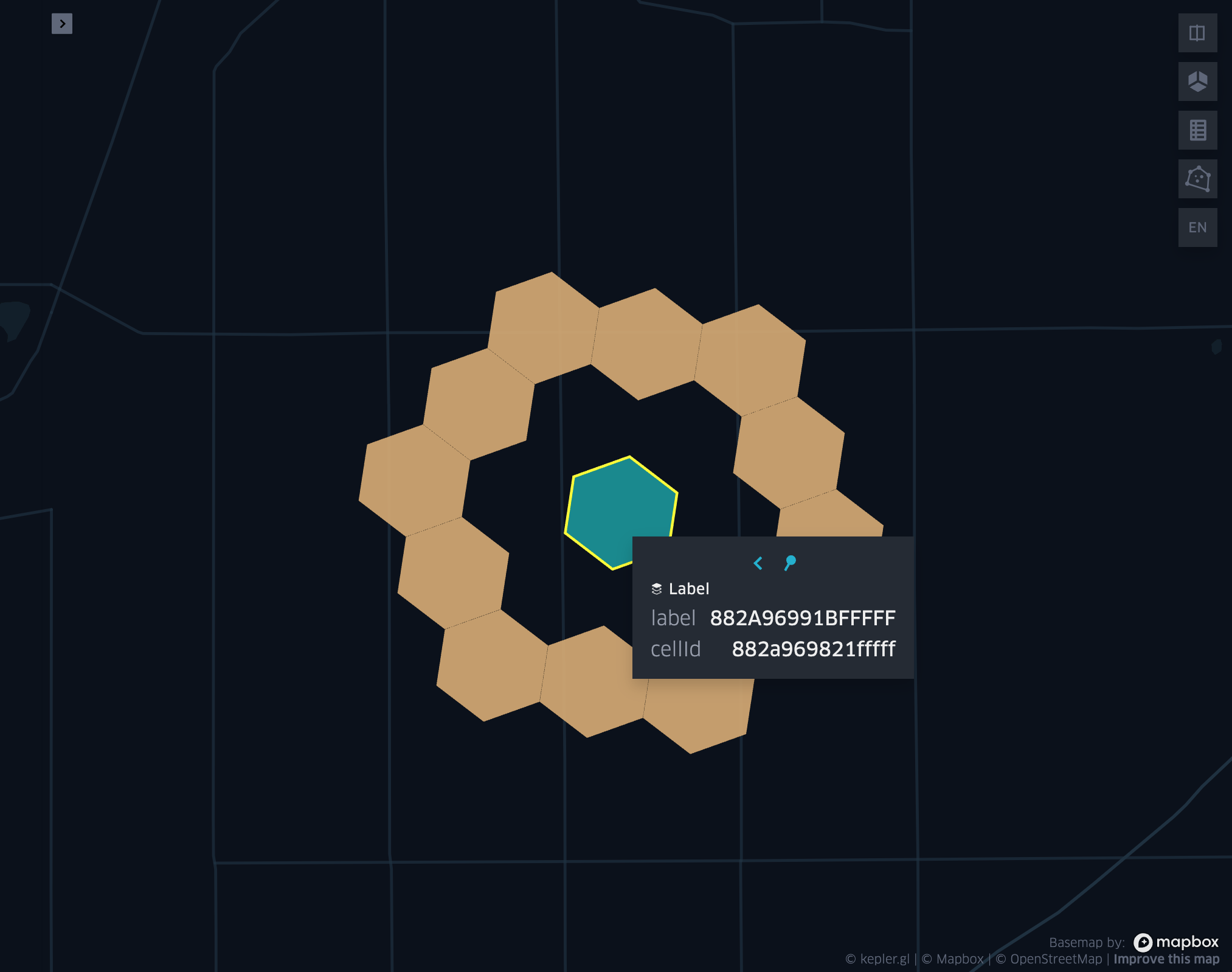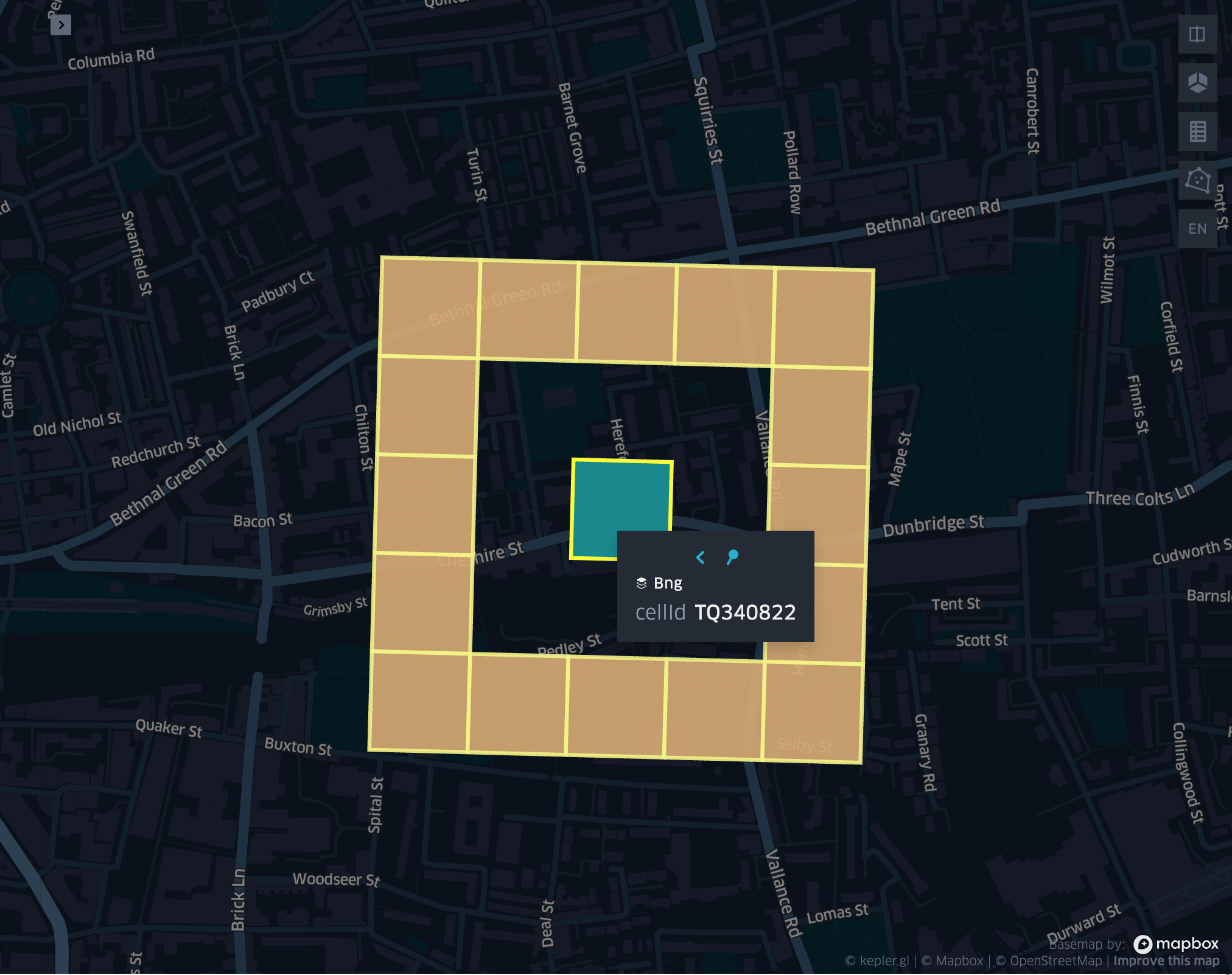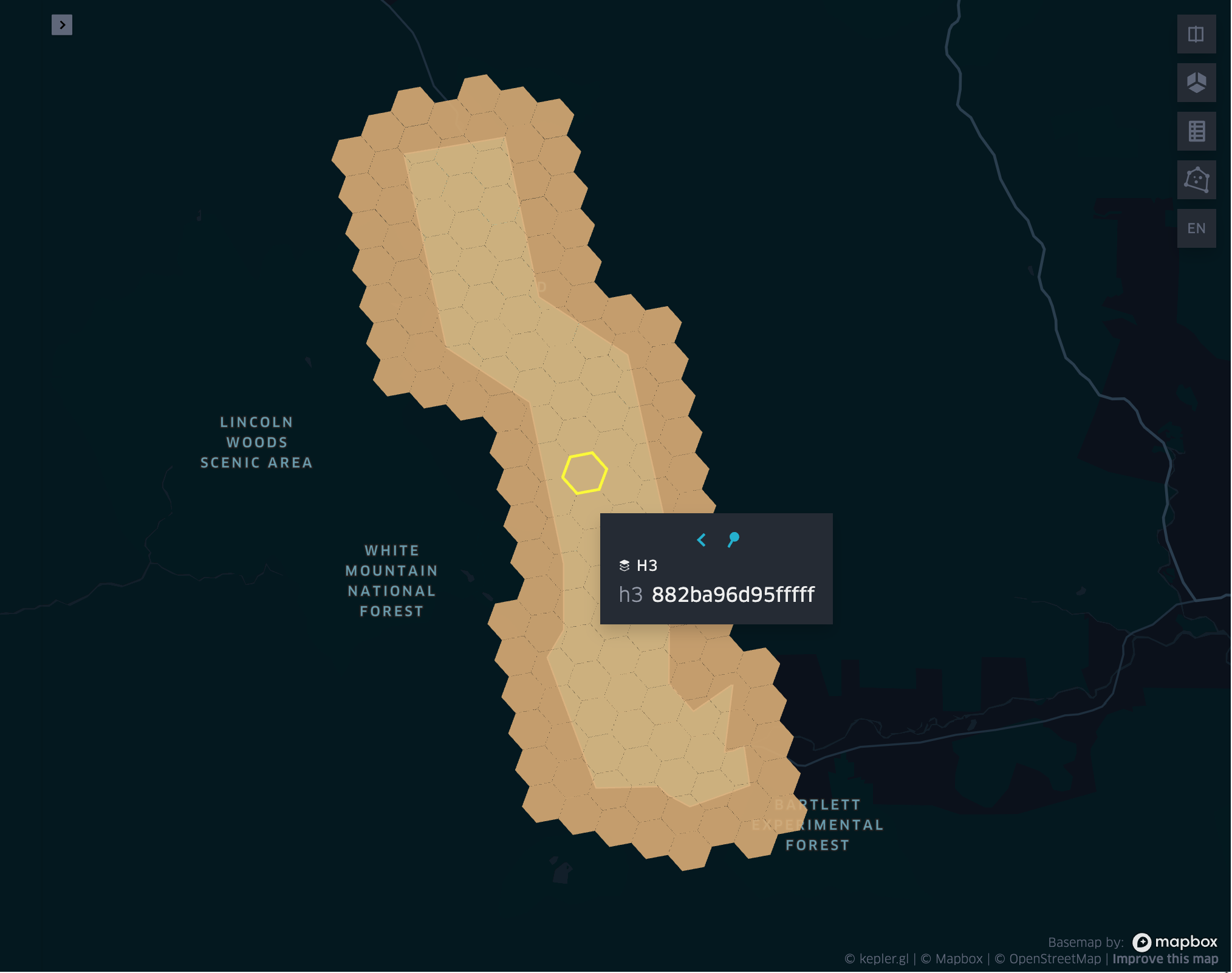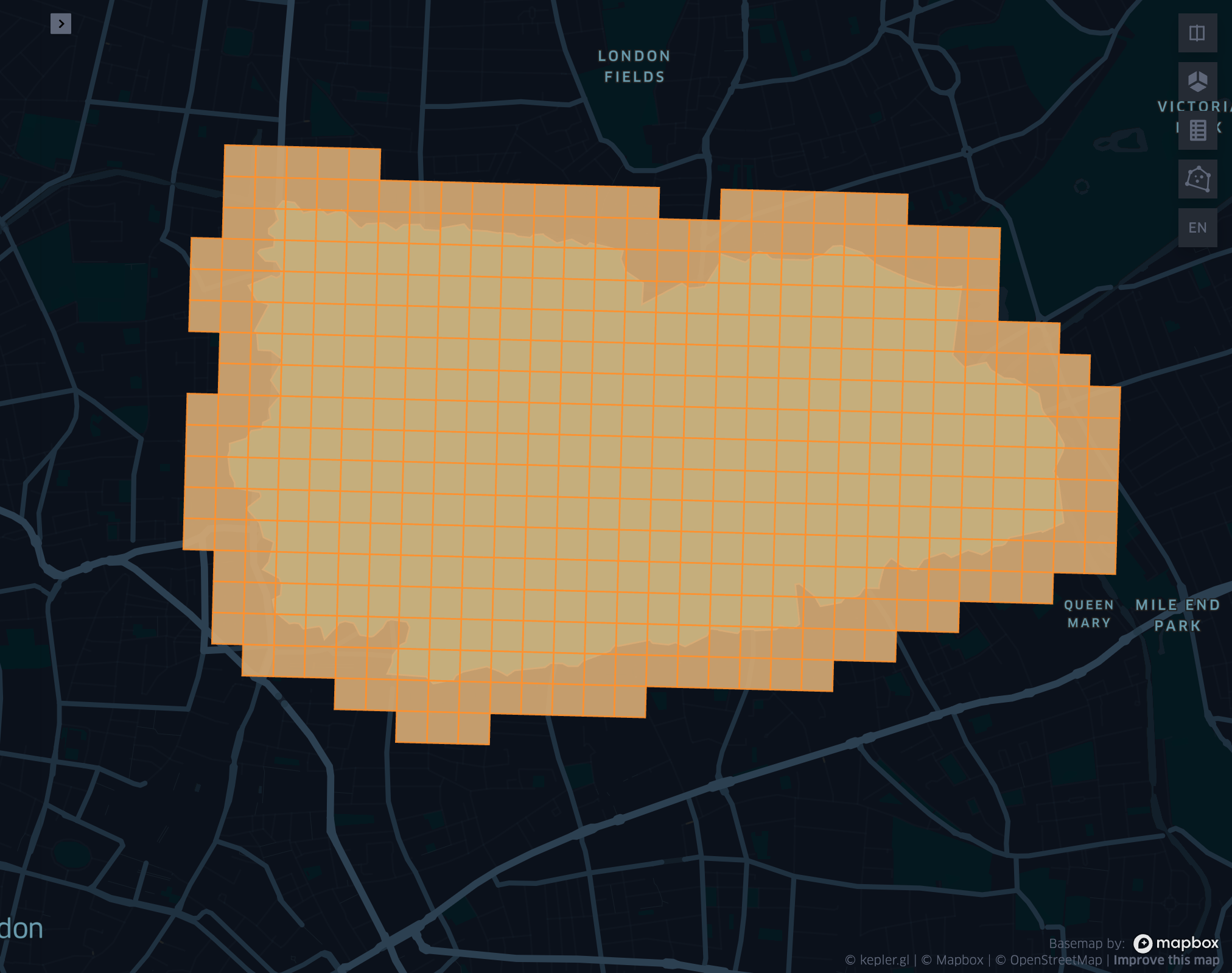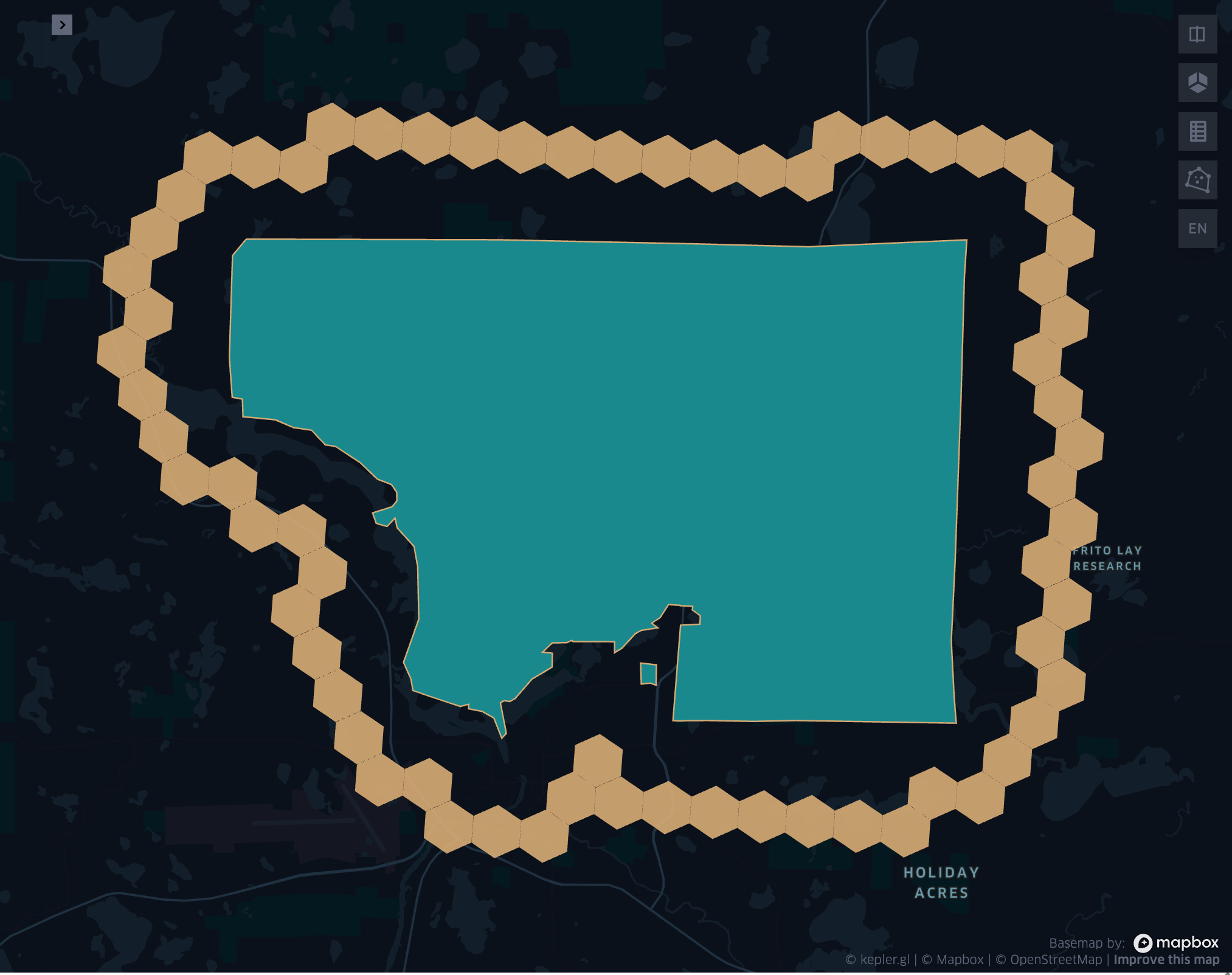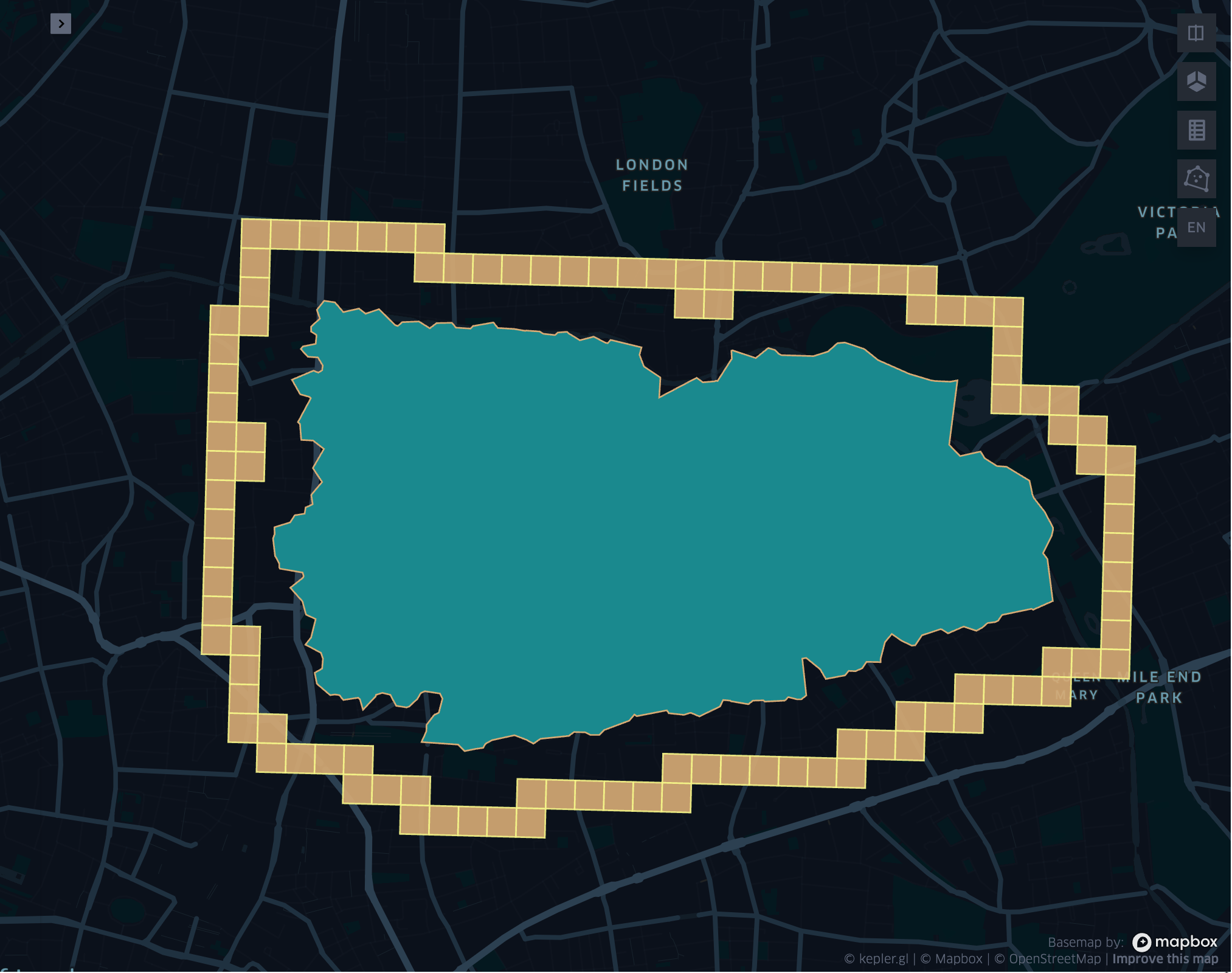Spatial grid indexing
Spatial grid indexing is the process of mapping a geometry (or a point) to one or more cells (or cell ID) from the selected spatial grid.
The grid system can be specified by using the spark configuration spark.databricks.labs.mosaic.index.system
before enabling Mosaic.
The valid values are:
H3- Good all-rounder for any location on earth
BNG- Local grid system Great Britain (EPSG:27700)
CUSTOM(minX,maxX,minY,maxY,splits,rootCellSizeX,rootCellSizeY)- Can be used with any local or global CRS
minX,maxX,minY,maxYcan be positive or negative integers defining the grid bounds
splitsdefines how many splits are applied to each cell for an increase in resolution step (usually 2 or 10)
rootCellSizeX,rootCellSizeYdefine the size of the cells on resolution 0
Example
spark.conf.set("spark.databricks.labs.mosaic.index.system", "H3") # Default
# spark.conf.set("spark.databricks.labs.mosaic.index.system", "BNG")
# spark.conf.set("spark.databricks.labs.mosaic.index.system", "CUSTOM(-180,180,-90,90,2,30,30)")
import mosaic as mos
mos.enable_mosaic(spark, dbutils)
grid_longlatascellid
- grid_longlatascellid(lon, lat, resolution)
Returns the
resolutiongrid index associated with the inputlonandlatcoordinates.- Parameters:
lon (Column: DoubleType) – Longitude
lat (Column: DoubleType) – Latitude
resolution (Column: Integer) – Index resolution
- Return type:
Column: LongType
- Example:
df = spark.createDataFrame([{'lon': 30., 'lat': 10.}])
df.select(grid_longlatascellid('lon', 'lat', lit(10))).show(1, False)
+----------------------------------+
|grid_longlatascellid(lon, lat, 10)|
+----------------------------------+
| 623385352048508927|
+----------------------------------+
val df = List((30.0, 10.0)).toDF("lon", "lat")
df.select(grid_longlatascellid(col("lon"), col("lat"), lit(10))).show()
+----------------------------------+
|grid_longlatascellid(lon, lat, 10)|
+----------------------------------+
| 623385352048508927|
+----------------------------------+
SELECT grid_longlatascellid(30d, 10d, 10)
+----------------------------------+
|grid_longlatascellid(lon, lat, 10)|
+----------------------------------+
| 623385352048508927|
+----------------------------------+
df <- createDataFrame(data.frame(lon = 30.0, lat = 10.0))
showDF(select(df, grid_longlatascellid(column("lon"), column("lat"), lit(10L))), truncate=F)
+----------------------------------+
|grid_longlatascellid(lon, lat, 10)|
+----------------------------------+
| 623385352048508927|
+----------------------------------+
grid_pointascellid
- grid_pointascellid(geometry, resolution)
Returns the
resolutiongrid index associated with the input point geometrygeometry.- Parameters:
geometry (Column) – Geometry
resolution (Column: Integer) – Index resolution
- Return type:
Column: LongType
- Example:
df = spark.createDataFrame([{'lon': 30., 'lat': 10.}])
df.select(grid_pointascellid(st_point('lon', 'lat'), lit(10))).show(1, False)
+------------------------------------------+
|grid_pointascellid(st_point(lon, lat), 10)|
+------------------------------------------+
|623385352048508927 |
+------------------------------------------+
val df = List((30.0, 10.0)).toDF("lon", "lat")
df.select(grid_pointascellid(st_point(col("lon"), col("lat")), lit(10))).show()
+------------------------------------------+
|grid_pointascellid(st_point(lon, lat), 10)|
+------------------------------------------+
|623385352048508927 |
+------------------------------------------+
SELECT grid_pointascellid(st_point(30d, 10d), 10)
+------------------------------------------+
|grid_pointascellid(st_point(lon, lat), 10)|
+------------------------------------------+
|623385352048508927 |
+------------------------------------------+
df <- createDataFrame(data.frame(lon = 30.0, lat = 10.0))
showDF(select(df, grid_pointascellid(st_point(column("lon"), column("lat")), lit(10L))), truncate=F)
+------------------------------------------+
|grid_pointascellid(st_point(lon, lat), 10)|
+------------------------------------------+
|623385352048508927 |
+------------------------------------------+
grid_polyfill
- grid_polyfill(geometry, resolution)
Returns the set of grid indices of which centroid is contained in the input
geometryatresolution.When using H3 index system, this is equivalent to the H3 polyfill method
- Parameters:
geometry (Column) – Geometry
resolution (Column: Integer) – Index resolution
- Return type:
Column: ArrayType[LongType]
- Example:
df = spark.createDataFrame([{
'wkt': 'MULTIPOLYGON (((30 20, 45 40, 10 40, 30 20)), ((15 5, 40 10, 10 20, 5 10, 15 5)))'
}])
df.select(grid_polyfill('wkt', lit(0))).show(1, False)
+------------------------------------------------------------+
|grid_polyfill(wkt, 0) |
+------------------------------------------------------------+
|[577586652210266111, 578360708396220415, 577269992861466623]|
+------------------------------------------------------------+
val df = List(("MULTIPOLYGON (((30 20, 45 40, 10 40, 30 20)), ((15 5, 40 10, 10 20, 5 10, 15 5)))")).toDF("wkt")
df.select(grid_polyfill(col("wkt"), lit(0))).show(false)
+------------------------------------------------------------+
|grid_polyfill(wkt, 0) |
+------------------------------------------------------------+
|[577586652210266111, 578360708396220415, 577269992861466623]|
+------------------------------------------------------------+
SELECT grid_polyfill("MULTIPOLYGON (((30 20, 45 40, 10 40, 30 20)), ((15 5, 40 10, 10 20, 5 10, 15 5)))", 0)
+------------------------------------------------------------+
|grid_polyfill(wkt, 0) |
+------------------------------------------------------------+
|[577586652210266111, 578360708396220415, 577269992861466623]|
+------------------------------------------------------------+
df <- createDataFrame(data.frame(wkt = "MULTIPOLYGON (((30 20, 45 40, 10 40, 30 20)), ((15 5, 40 10, 10 20, 5 10, 15 5)))"))
showDF(select(df, grid_polyfill(column("wkt"), lit(0L))), truncate=F)
+------------------------------------------------------------+
|grid_polyfill(wkt, 0) |
+------------------------------------------------------------+
|[577586652210266111, 578360708396220415, 577269992861466623]|
+------------------------------------------------------------+
grid_boundaryaswkb
- grid_boundaryaswkb(cellid)
Returns the boundary of the grid cell as a WKB.
- Parameters:
cellid (Column: Union(LongType, StringType)) – Grid cell id
- Example:
df = spark.createDataFrame([{'cellid': 613177664827555839}])
df.select(grid_boundaryaswkb("cellid").show(1, False)
+--------------------------+
|grid_boundaryaswkb(cellid)|
+--------------------------+
|[01 03 00 00 00 00 00 00..|
+--------------------------+
val df = List((613177664827555839)).toDF("cellid")
df.select(grid_boundaryaswkb(col("cellid")).show()
+--------------------------+
|grid_boundaryaswkb(cellid)|
+--------------------------+
|[01 03 00 00 00 00 00 00..|
+--------------------------+
SELECT grid_boundaryaswkb(613177664827555839)
+--------------------------+
|grid_boundaryaswkb(cellid)|
+--------------------------+
|[01 03 00 00 00 00 00 00..|
+--------------------------+
df <- createDataFrame(data.frame(cellid = 613177664827555839))
showDF(select(df, grid_boundaryaswkb(column("cellid")), truncate=F)
+--------------------------+
|grid_boundaryaswkb(cellid)|
+--------------------------+
|[01 03 00 00 00 00 00 00..|
+--------------------------+
grid_boundary
- grid_boundary(cellid, format)
Returns the boundary of the grid cell as a geometry in specified format.
- Parameters:
cellid (Column: Union(LongType, StringType)) – Grid cell id
format (Column: StringType) – Geometry format
- Example:
df = spark.createDataFrame([{'cellid': 613177664827555839}])
df.select(grid_boundary("cellid", "WKT").show(1, False)
+--------------------------+
|grid_boundary(cellid, WKT)|
+--------------------------+
| "POLYGON (( ..."|
+--------------------------+
val df = List((613177664827555839)).toDF("cellid")
df.select(grid_boundary(col("cellid"), lit("WKT").show()
+--------------------------+
|grid_boundary(cellid, WKT)|
+--------------------------+
| "POLYGON (( ..."|
+--------------------------+
SELECT grid_boundary(613177664827555839, "WKT")
+--------------------------+
|grid_boundary(cellid, WKT)|
+--------------------------+
| "POLYGON (( ..."|
+--------------------------+
df <- createDataFrame(data.frame(cellid = 613177664827555839))
showDF(select(df, grid_boundary(column("cellid"), lit("WKT")), truncate=F)
+--------------------------+
|grid_boundary(cellid, WKT)|
+--------------------------+
| "POLYGON (( ..."|
+--------------------------+
grid_tessellate
- grid_tessellate(geometry, resolution, <keep_core_geometries>)
Cuts the original
geometryinto several pieces along the grid index borders at the specifiedresolution.Returns an array of Mosaic chips covering the input
geometryatresolution.A Mosaic chip is a struct type composed of:
is_core: Identifies if the chip is fully contained within the geometry: Booleanindex_id: Index ID of the configured spatial indexing (default H3): Integerwkb: Geometry in WKB format equal to the intersection of the index shape and the originalgeometry: Binary
In contrast to grid_tessellateexplode, grid_tessellate does not explode the list of shapes.
In contrast to grid_polyfill, grid_tessellate fully covers the original
geometryeven if the index centroid falls outside of the original geometry. This makes it suitable to index lines as well.- Parameters:
geometry (Column) – Geometry
resolution (Column (IntegerType)) – Index resolution
keep_core_geometries (Column (BooleanType)) – Whether to keep the core geometries or set them to null, default true
- Return type:
Column: ArrayType[MosaicType]
- Example:
df = spark.createDataFrame([{'wkt': 'MULTIPOLYGON (((30 20, 45 40, 10 40, 30 20)), ((15 5, 40 10, 10 20, 5 10, 15 5)))'}])
df.select(grid_tessellate('wkt', lit(0))).printSchema()
root
|-- grid_tessellate(wkt, 0): mosaic (nullable = true)
| |-- chips: array (nullable = true)
| | |-- element: mosaic_chip (containsNull = true)
| | | |-- is_core: boolean (nullable = true)
| | | |-- index_id: long (nullable = true)
| | | |-- wkb: binary (nullable = true)
df.select(grid_tessellate('wkt', lit(0))).show()
+-----------------------+
|grid_tessellate(wkt, 0)|
+-----------------------+
| {[{false, 5774810...|
+-----------------------+
val df = List(("MULTIPOLYGON (((30 20, 45 40, 10 40, 30 20)), ((15 5, 40 10, 10 20, 5 10, 15 5)))")).toDF("wkt")
df.select(grid_tessellate(col("wkt"), lit(0))).printSchema
root
|-- grid_tessellate(wkt, 0): mosaic (nullable = true)
| |-- chips: array (nullable = true)
| | |-- element: mosaic_chip (containsNull = true)
| | | |-- is_core: boolean (nullable = true)
| | | |-- index_id: long (nullable = true)
| | | |-- wkb: binary (nullable = true)
df.select(grid_tessellate(col("wkt"), lit(0))).show()
+-----------------------+
|grid_tessellate(wkt, 0)|
+-----------------------+
| {[{false, 5774810...|
+-----------------------+
SELECT grid_tessellate("MULTIPOLYGON (((30 20, 45 40, 10 40, 30 20)), ((15 5, 40 10, 10 20, 5 10, 15 5)))", 0)
+-----------------------+
|grid_tessellate(wkt, 0)|
+-----------------------+
| {[{false, 5774810...|
+-----------------------+
df <- createDataFrame(data.frame(wkt = "MULTIPOLYGON (((30 20, 45 40, 10 40, 30 20)), ((15 5, 40 10, 10 20, 5 10, 15 5)))"))
schema(select(df, grid_tessellate(column("wkt"), lit(0L))))
root
|-- grid_tessellate(wkt, 0): mosaic (nullable = true)
| |-- chips: array (nullable = true)
| | |-- element: mosaic_chip (containsNull = true)
| | | |-- is_core: boolean (nullable = true)
| | | |-- index_id: long (nullable = true)
| | | |-- wkb: binary (nullable = true)
showDF(select(df, grid_tessellate(column("wkt"), lit(0L))))
+-----------------------+
|grid_tessellate(wkt, 0)|
+-----------------------+
| {[{false, 5774810...|
+-----------------------+
grid_tessellateexplode
- grid_tessellateexplode(geometry, resolution, <keep_core_geometries>)
Cuts the original
geometryinto several pieces along the grid index borders at the specifiedresolution.Returns the set of Mosaic chips covering the input
geometryatresolution.A Mosaic chip is a struct type composed of:
is_core: Identifies if the chip is fully contained within the geometry: Booleanindex_id: Index ID of the configured spatial indexing (default H3): Integerwkb: Geometry in WKB format equal to the intersection of the index shape and the originalgeometry: Binary
In contrast to grid_tessellate, grid_tessellateexplode generates one result row per chip.
In contrast to grid_polyfill, grid_tessellateexplode fully covers the original
geometryeven if the index centroid falls outside of the original geometry. This makes it suitable to index lines as well.- Parameters:
geometry (Column) – Geometry
resolution (Column (IntegerType)) – Index resolution
keep_core_geometries (Column (BooleanType)) – Whether to keep the core geometries or set them to null, default true
- Return type:
Column: MosaicType
- Example:
df = spark.createDataFrame([{'wkt': 'MULTIPOLYGON (((30 20, 45 40, 10 40, 30 20)), ((15 5, 40 10, 10 20, 5 10, 15 5)))'}])
df.select(grid_tessellateexplode('wkt', lit(0))).show()
+-----------------------------------------------+
|is_core| index_id| wkb|
+-------+------------------+--------------------+
| false|577481099093999615|[01 03 00 00 00 0...|
| false|578044049047420927|[01 03 00 00 00 0...|
| false|578782920861286399|[01 03 00 00 00 0...|
| false|577023702256844799|[01 03 00 00 00 0...|
| false|577938495931154431|[01 03 00 00 00 0...|
| false|577586652210266111|[01 06 00 00 00 0...|
| false|577269992861466623|[01 03 00 00 00 0...|
| false|578360708396220415|[01 03 00 00 00 0...|
+-------+------------------+--------------------+
val df = List(("MULTIPOLYGON (((30 20, 45 40, 10 40, 30 20)), ((15 5, 40 10, 10 20, 5 10, 15 5)))")).toDF("wkt")
df.select(grid_tessellateexplode(col("wkt"), lit(0))).show()
+-----------------------------------------------+
|is_core| index_id| wkb|
+-------+------------------+--------------------+
| false|577481099093999615|[01 03 00 00 00 0...|
| false|578044049047420927|[01 03 00 00 00 0...|
| false|578782920861286399|[01 03 00 00 00 0...|
| false|577023702256844799|[01 03 00 00 00 0...|
| false|577938495931154431|[01 03 00 00 00 0...|
| false|577586652210266111|[01 06 00 00 00 0...|
| false|577269992861466623|[01 03 00 00 00 0...|
| false|578360708396220415|[01 03 00 00 00 0...|
+-------+------------------+--------------------+
SELECT grid_tessellateexplode("MULTIPOLYGON (((30 20, 45 40, 10 40, 30 20)), ((15 5, 40 10, 10 20, 5 10, 15 5)))", 0)
+-----------------------------------------------+
|is_core| index_id| wkb|
+-------+------------------+--------------------+
| false|577481099093999615|[01 03 00 00 00 0...|
| false|578044049047420927|[01 03 00 00 00 0...|
| false|578782920861286399|[01 03 00 00 00 0...|
| false|577023702256844799|[01 03 00 00 00 0...|
| false|577938495931154431|[01 03 00 00 00 0...|
| false|577586652210266111|[01 06 00 00 00 0...|
| false|577269992861466623|[01 03 00 00 00 0...|
| false|578360708396220415|[01 03 00 00 00 0...|
+-------+------------------+--------------------+
df <- createDataFrame(data.frame(wkt = 'MULTIPOLYGON (((30 20, 45 40, 10 40, 30 20)), ((15 5, 40 10, 10 20, 5 10, 15 5)))'))
showDF(select(df, grid_tessellateexplode(column("wkt"), lit(0L))))
+-----------------------------------------------+
|is_core| index_id| wkb|
+-------+------------------+--------------------+
| false|577481099093999615|[01 03 00 00 00 0...|
| false|578044049047420927|[01 03 00 00 00 0...|
| false|578782920861286399|[01 03 00 00 00 0...|
| false|577023702256844799|[01 03 00 00 00 0...|
| false|577938495931154431|[01 03 00 00 00 0...|
| false|577586652210266111|[01 06 00 00 00 0...|
| false|577269992861466623|[01 03 00 00 00 0...|
| false|578360708396220415|[01 03 00 00 00 0...|
+-------+------------------+--------------------+
grid_cellarea
- grid_cellarea(cellid)
Returns the area of a given cell in km^2.
- Parameters:
cellid (Column: Long) – Grid cell ID
- Return type:
Column: DoubleType
- Example:
df = spark.createDataFrame([{'grid_cellid': 613177664827555839}])
df.withColumn(grid_cellarea('grid_cellid').alias("area")).show()
+------------------------------------+
| grid_cellid| area|
+--------------------+---------------+
| 613177664827555839| 0.78595419|
+--------------------+---------------+
val df = List((613177664827555839)).toDF("grid_cellid")
df.select(grid_cellarea('grid_cellid').alias("area")).show()
+------------------------------------+
| grid_cellid| area|
+--------------------+---------------+
| 613177664827555839| 0.78595419|
+--------------------+---------------+
SELECT grid_cellarea(613177664827555839)
+------------------------------------+
| grid_cellid| area|
+--------------------+---------------+
| 613177664827555839| 0.78595419|
+--------------------+---------------+
df <- createDataFrame(data.frame(grid_cellid = 613177664827555839))
showDF(select(df, grid_cellarea(column("grid_cellid"))))
+------------------------------------+
| grid_cellid| area|
+--------------------+---------------+
| 613177664827555839| 0.78595419|
+--------------------+---------------+
grid_cellkring
- grid_cellkring(cellid, k)
Returns the k-ring of a given cell.
- Parameters:
cellid (Column: Long) – Grid cell ID
k (Column: Integer) – K-ring size
- Return type:
Column: ArrayType(Long)
- Example:
df = spark.createDataFrame([{'grid_cellid': 613177664827555839}])
df.select(grid_cellkring('grid_cellid', lit(2)).alias("kring")).show()
+-------------------------------------------------------------------+
| grid_cellid| kring|
+--------------------+----------------------------------------------+
| 613177664827555839|[613177664827555839, 613177664825458687, ....]|
+--------------------+----------------------------------------------+
val df = List((613177664827555839)).toDF("grid_cellid")
df.select(grid_cellkring('grid_cellid', lit(2)).alias("kring")).show()
+-------------------------------------------------------------------+
| grid_cellid| kring|
+--------------------+----------------------------------------------+
| 613177664827555839|[613177664827555839, 613177664825458687, ....]|
+--------------------+----------------------------------------------+
SELECT grid_cellkring(613177664827555839, 2)
+-------------------------------------------------------------------+
| grid_cellid| kring|
+--------------------+----------------------------------------------+
| 613177664827555839|[613177664827555839, 613177664825458687, ....]|
+--------------------+----------------------------------------------+
df <- createDataFrame(data.frame(grid_cellid = 613177664827555839))
showDF(select(df, grid_cellkring(column("grid_cellid"), lit(2L))))
+-------------------------------------------------------------------+
| grid_cellid| kring|
+--------------------+----------------------------------------------+
| 613177664827555839|[613177664827555839, 613177664825458687, ....]|
+--------------------+----------------------------------------------+
grid_cellkringexplode
- grid_cellkringexplode(cellid, k)
Returns the k-ring of a given cell exploded.
- Parameters:
cellid (Column: Long) – Grid cell ID
k (Column: Integer) – K-ring size
- Return type:
Column: Long
- Example:
df = spark.createDataFrame([{'grid_cellid': 613177664827555839}])
df.select(grid_cellkringexplode('grid_cellid', lit(2)).alias("kring")).show()
+------------------+
| kring|
+------------------+
|613177664827555839|
|613177664825458687|
|613177664831750143|
|613177664884178943|
| ...|
+------------------+
val df = List((613177664827555839)).toDF("grid_cellid")
df.select(grid_cellkringexplode('grid_cellid', lit(2)).alias("kring")).show()
+------------------+
| kring|
+------------------+
|613177664827555839|
|613177664825458687|
|613177664831750143|
|613177664884178943|
| ...|
+------------------+
SELECT grid_cellkringexplode(613177664827555839, 2)
+------------------+
| kring|
+------------------+
|613177664827555839|
|613177664825458687|
|613177664831750143|
|613177664884178943|
| ...|
+------------------+
df <- createDataFrame(data.frame(grid_cellid = 613177664827555839))
showDF(select(df, grid_cellkringexplode(column("grid_cellid"), lit(2L))))
+------------------+
| kring|
+------------------+
|613177664827555839|
|613177664825458687|
|613177664831750143|
|613177664884178943|
| ...|
+------------------+
grid_cell_intersection
- grid_cell_intersection(left_chip, right_chip)
Returns the chip representing the intersection of two chips based on the same grid cell. Also, see grid_cell_intersection_agg function.
- Parameters:
left_chip (Column: ChipType(LongType)) – Chip
left_chip – Chip
- Return type:
Column: ChipType(LongType)
- Example:
df = spark.createDataFrame([{"chip": {"is_core": False, "index_id": 590418571381702655, "wkb": ...}})])
df.select(grid_cell_intersection("chip", "chip").alias("intersection")).show()
---------------------------------------------------------+
| intersection |
+--------------------------------------------------------+
|{is_core: false, index_id: 590418571381702655, wkb: ...}|
+--------------------------------------------------------+
val df = List((...)).toDF("chip")
df.select(grid_cell_intersection("chip", "chip").alias("intersection")).show()
---------------------------------------------------------+
| intersection |
+--------------------------------------------------------+
|{is_core: false, index_id: 590418571381702655, wkb: ...}|
+--------------------------------------------------------+
SELECT grid_cell_intersection({"is_core": False, "index_id": 590418571381702655, "wkb": ...})
---------------------------------------------------------+
| intersection |
+--------------------------------------------------------+
|{is_core: false, index_id: 590418571381702655, wkb: ...}|
+--------------------------------------------------------+
df <- createDataFrame(data.frame(...))
showDF(select(df, grid_cell_intersection(column("chip"))))
---------------------------------------------------------+
| intersection |
+--------------------------------------------------------+
|{is_core: false, index_id: 590418571381702655, wkb: ...}|
+--------------------------------------------------------+
grid_cell_union
- grid_cell_union(left_chip, right_chip)
Returns the chip representing the union of two chips based on the same grid cell. Also, see grid_cell_union_agg function.
- Parameters:
left_chip (Column: ChipType(LongType)) – Chip
left_chip – Chip
- Return type:
Column: ChipType(LongType)
- Example:
df = spark.createDataFrame([{"chip": {"is_core": False, "index_id": 590418571381702655, "wkb": ...}})])
df.select(grid_cell_union("chip", "chip").alias("union")).show()
---------------------------------------------------------+
| union |
+--------------------------------------------------------+
|{is_core: false, index_id: 590418571381702655, wkb: ...}|
+--------------------------------------------------------+
val df = List((...)).toDF("chip")
df.select(grid_cell_union("chip", "chip").alias("union")).show()
---------------------------------------------------------+
| union |
+--------------------------------------------------------+
|{is_core: false, index_id: 590418571381702655, wkb: ...}|
+--------------------------------------------------------+
SELECT grid_cell_union({"is_core": False, "index_id": 590418571381702655, "wkb": ...})
---------------------------------------------------------+
| union |
+--------------------------------------------------------+
|{is_core: false, index_id: 590418571381702655, wkb: ...}|
+--------------------------------------------------------+
df <- createDataFrame(data.frame(...))
showDF(select(df, grid_cell_union(column("chip"))))
---------------------------------------------------------+
| union |
+--------------------------------------------------------+
|{is_core: false, index_id: 590418571381702655, wkb: ...}|
+--------------------------------------------------------+
grid_cellkloop
- grid_cellkloop(cellid, k)
Returns the k loop (hollow ring) of a given cell.
- Parameters:
cellid (Column: Long) – Grid cell ID
k (Column: Integer) – K-loop size
- Return type:
Column: ArrayType(Long)
- Example:
df = spark.createDataFrame([{'grid_cellid': 613177664827555839}])
df.select(grid_cellkloop('grid_cellid', lit(2)).alias("kloop")).show()
+-------------------------------------------------------------------+
| grid_cellid| kloop|
+--------------------+----------------------------------------------+
| 613177664827555839|[613177664827555839, 613177664825458687, ....]|
+--------------------+----------------------------------------------+
val df = List((613177664827555839)).toDF("grid_cellid")
df.select(grid_cellkloop('grid_cellid', lit(2)).alias("kloop")).show()
+-------------------------------------------------------------------+
| grid_cellid| kloop|
+--------------------+----------------------------------------------+
| 613177664827555839|[613177664827555839, 613177664825458687, ....]|
+--------------------+----------------------------------------------+
SELECT grid_cellkloop(613177664827555839, 2)
+-------------------------------------------------------------------+
| grid_cellid| kloop|
+--------------------+----------------------------------------------+
| 613177664827555839|[613177664827555839, 613177664825458687, ....]|
+--------------------+----------------------------------------------+
df <- createDataFrame(data.frame(grid_cellid = 613177664827555839))
showDF(select(df, grid_cellkloop(column("grid_cellid"), lit(2L))))
+-------------------------------------------------------------------+
| grid_cellid| kloop|
+--------------------+----------------------------------------------+
| 613177664827555839|[613177664827555839, 613177664825458687, ....]|
+--------------------+----------------------------------------------+
grid_cellkloopexplode
- grid_cellkloopexplode(cellid, k)
Returns the k loop (hollow ring) of a given cell exploded.
- Parameters:
cellid (Column: Long) – Grid cell ID
k (Column: Integer) – K-loop size
- Return type:
Column: Long
- Example:
df = spark.createDataFrame([{'grid_cellid': 613177664827555839}])
df.select(grid_cellkloopexplode('grid_cellid', lit(2)).alias("kloop")).show()
+------------------+
| kloop|
+------------------+
|613177664827555839|
|613177664825458687|
|613177664831750143|
|613177664884178943|
| ...|
+------------------+
val df = List((613177664827555839)).toDF("grid_cellid")
df.select(grid_cellkloopexplode('grid_cellid', lit(2)).alias("kloop")).show()
+------------------+
| kloop|
+------------------+
|613177664827555839|
|613177664825458687|
|613177664831750143|
|613177664884178943|
| ...|
+------------------+
SELECT grid_cellkloopexplode(613177664827555839, 2)
+------------------+
| kloop|
+------------------+
|613177664827555839|
|613177664825458687|
|613177664831750143|
|613177664884178943|
| ...|
+------------------+
df <- createDataFrame(data.frame(grid_cellid = 613177664827555839))
showDF(select(df, grid_cellkloopexplode(column("grid_cellid"), lit(2L))))
+------------------+
| kloop|
+------------------+
|613177664827555839|
|613177664825458687|
|613177664831750143|
|613177664884178943|
| ...|
+------------------+
grid_geometrykring
- grid_geometrykring(geometry, resolution, k)
Returns the k-ring of a given geometry respecting the boundary shape.
- Parameters:
geometry (Column) – Geometry to be used
resolution (Column: Integer) – Resolution of the index used to calculate the k-ring
k (Column: Integer) – K-ring size
- Return type:
Column: ArrayType(Long)
- Example:
df = spark.createDataFrame([{'geometry': "MULTIPOLYGON (((30 20, 45 40, 10 40, 30 20)), ((15 5, 40 10, 10 20, 5 10, 15 5)))"}])
df.select(grid_geometrykring('geometry', lit(8), lit(1)).alias("kring")).show()
+-------------------------------------------------------------------+
| geometry| kring|
+--------------------+----------------------------------------------+
| "MULTIPOLYGON(..."|[613177664827555839, 613177664825458687, ....]|
+--------------------+----------------------------------------------+
val df = List((613177664827555839)).toDF("geometry")
df.select(grid_geometrykring('geometry', lit(8), lit(1)).alias("kring")).show()
+-------------------------------------------------------------------+
| geometry| kring|
+--------------------+----------------------------------------------+
| "MULTIPOLYGON(..."|[613177664827555839, 613177664825458687, ....]|
+--------------------+----------------------------------------------+
SELECT grid_geometrykring('MULTIPOLYGON (((30 20, 45 40, 10 40, 30 20)), ((15 5, 40 10, 10 20, 5 10, 15 5)))', 8, 1)
+-------------------------------------------------------------------+
| geometry| kring|
+--------------------+----------------------------------------------+
| "MULTIPOLYGON(..."|[613177664827555839, 613177664825458687, ....]|
+--------------------+----------------------------------------------+
df <- createDataFrame(data.frame(geometry = 613177664827555839))
showDF(select(df, grid_geometrykring('geometry', lit(8L), lit(1L))))
+-------------------------------------------------------------------+
| geometry| kring|
+--------------------+----------------------------------------------+
| "MULTIPOLYGON(..."|[613177664827555839, 613177664825458687, ....]|
+--------------------+----------------------------------------------+
grid_geometrykringexplode
- grid_geometrykringexplode(geometry, resolution, k)
Returns the k-ring of a given geometry exploded.
- Parameters:
geometry (Column) – Geometry to be used
resolution (Column: Integer) – Resolution of the index used to calculate the k-ring
k (Column: Integer) – K-ring size
- Return type:
Column: Long
- Example:
df = spark.createDataFrame([{'geometry': "MULTIPOLYGON (((30 20, 45 40, 10 40, 30 20)), ((15 5, 40 10, 10 20, 5 10, 15 5)))"}])
df.select(grid_geometrykringexplode('geometry', lit(8), lit(2)).alias("kring")).show()
+------------------+
| kring|
+------------------+
|613177664827555839|
|613177664825458687|
|613177664831750143|
|613177664884178943|
| ...|
+------------------+
val df = List(("MULTIPOLYGON (((30 20, 45 40, 10 40, 30 20)), ((15 5, 40 10, 10 20, 5 10, 15 5)))")).toDF("geometry")
df.select(grid_geometrykringexplode('geometry', lit(8), lit(2)).alias("kring")).show()
+------------------+
| kring|
+------------------+
|613177664827555839|
|613177664825458687|
|613177664831750143|
|613177664884178943|
| ...|
+------------------+
SELECT grid_geometrykringexplode("MULTIPOLYGON (((30 20, 45 40, 10 40, 30 20)), ((15 5, 40 10, 10 20, 5 10, 15 5)))", 8, 2)
+------------------+
| kring|
+------------------+
|613177664827555839|
|613177664825458687|
|613177664831750143|
|613177664884178943|
| ...|
+------------------+
df <- createDataFrame(data.frame(geometry = "MULTIPOLYGON (((30 20, 45 40, 10 40, 30 20)), ((15 5, 40 10, 10 20, 5 10, 15 5)))"))
showDF(select(df, grid_cellkringexplode(column("geometry"), lit(8L), lit(2L))))
+------------------+
| kring|
+------------------+
|613177664827555839|
|613177664825458687|
|613177664831750143|
|613177664884178943|
| ...|
+------------------+
grid_geometrykloop
- grid_geometrykloop(geometry, resolution, k)
Returns the k-loop (hollow ring) of a given geometry.
- Parameters:
geometry (Column) – Geometry to be used
resolution (Column: Integer) – Resolution of the index used to calculate the k loop
k (Column: Integer) – K-Loop size
- Return type:
Column: ArrayType(Long)
- Example:
df = spark.createDataFrame([{'geometry': "MULTIPOLYGON (((30 20, 45 40, 10 40, 30 20)), ((15 5, 40 10, 10 20, 5 10, 15 5)))"}])
df.select(grid_geometrykloop('geometry', lit(2)).alias("kloop")).show()
+-------------------------------------------------------------------+
| geometry| kloop|
+--------------------+----------------------------------------------+
| MULTIPOLYGON ((...|[613177664827555839, 613177664825458687, ....]|
+--------------------+----------------------------------------------+
val df = List(("MULTIPOLYGON (((30 20, 45 40, 10 40, 30 20)), ((15 5, 40 10, 10 20, 5 10, 15 5)))")).toDF("geometry")
df.select(grid_cellkloop('geometry', lit(2)).alias("kloop")).show()
+-------------------------------------------------------------------+
| geometry| kloop|
+--------------------+----------------------------------------------+
| MULTIPOLYGON ((...|[613177664827555839, 613177664825458687, ....]|
+--------------------+----------------------------------------------+
SELECT grid_cellkloop("MULTIPOLYGON (((30 20, 45 40, 10 40, 30 20)), ((15 5, 40 10, 10 20, 5 10, 15 5)))", 2)
+-------------------------------------------------------------------+
| geometry| kloop|
+--------------------+----------------------------------------------+
| MULTIPOLYGON ((...|[613177664827555839, 613177664825458687, ....]|
+--------------------+----------------------------------------------+
df <- createDataFrame(data.frame(geometry = "MULTIPOLYGON (((30 20, 45 40, 10 40, 30 20)), ((15 5, 40 10, 10 20, 5 10, 15 5)))"))
showDF(select(df, grid_cellkloop(column("geometry"), lit(2L))))
+-------------------------------------------------------------------+
| geometry| kloop|
+--------------------+----------------------------------------------+
| MULTIPOLYGON ((...|[613177664827555839, 613177664825458687, ....]|
+--------------------+----------------------------------------------+
grid_geometrykloopexplode
- grid_geometrykloopexplode(geometry, resolution, k)
Returns the k loop (hollow ring) of a given geometry exploded.
- Parameters:
geometry (Column) – Geometry to be used
resolution (Column: Integer) – Resolution of the index used to calculate the k loop
k (Column: Integer) – K-loop size
- Return type:
Column: Long
- Example:
df = spark.createDataFrame([{'geometry': "MULTIPOLYGON (((30 20, 45 40, 10 40, 30 20)), ((15 5, 40 10, 10 20, 5 10, 15 5)))"}])
df.select(grid_geometrykloopexplode('geometry', lit(8), lit(2)).alias("kloop")).show()
+------------------+
| kloop|
+------------------+
|613177664827555839|
|613177664825458687|
|613177664831750143|
|613177664884178943|
| ...|
+------------------+
val df = List(("MULTIPOLYGON (((30 20, 45 40, 10 40, 30 20)), ((15 5, 40 10, 10 20, 5 10, 15 5)))")).toDF("geometry")
df.select(grid_geometrykloopexplode('geometry', lit(8), lit(2)).alias("kloop")).show()
+------------------+
| kloop|
+------------------+
|613177664827555839|
|613177664825458687|
|613177664831750143|
|613177664884178943|
| ...|
+------------------+
SELECT grid_geometrykloopexplode("MULTIPOLYGON (((30 20, 45 40, 10 40, 30 20)), ((15 5, 40 10, 10 20, 5 10, 15 5)))", 8, 2)
+------------------+
| kloop|
+------------------+
|613177664827555839|
|613177664825458687|
|613177664831750143|
|613177664884178943|
| ...|
+------------------+
df <- createDataFrame(data.frame(geometry = "MULTIPOLYGON (((30 20, 45 40, 10 40, 30 20)), ((15 5, 40 10, 10 20, 5 10, 15 5)))"))
showDF(select(df, grid_geometrykloopexplode(column("geometry"), lit(8L), lit(2L))))
+------------------+
| kloop|
+------------------+
|613177664827555839|
|613177664825458687|
|613177664831750143|
|613177664884178943|
| ...|
+------------------+

